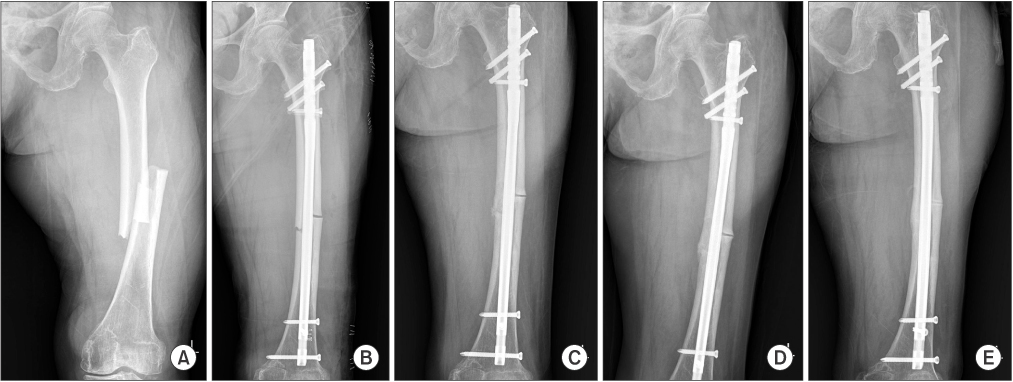J Korean Orthop Assoc.
2016 Jun;51(3):231-237. 10.4055/jkoa.2016.51.3.231.
Effects of Teriparatide Administration on Fracture Healing after Intramedullary Nailing in Atypical Femoral Fractures
- Affiliations
-
- 1Department of Orthopedic Surgery, Yeungnam University Hospital, Yeungnam University College of Medicine, Daegu, Korea. ossoj@med.yu.ac.kr
- 2Department of Orthopedic Surgery, Kangnam Hospital, Daegu, Korea.
- KMID: 2308584
- DOI: http://doi.org/10.4055/jkoa.2016.51.3.231
Abstract
- PURPOSE
The purpose of this study is to evaluate the effects of teriparatide administration on fracture healing after intramedullary nailing in atypical femoral fractures.
MATERIALS AND METHODS
We retrospectively reviewed 26 patients (26 cases) with atypical femoral fracture who were treated using intramedullary nailing between January 2009 and December 2013. Teriparatide was not administered to 15 patients (non-injection group) and was administered to 11 patients after surgery (injection group). Clinical results were assessed using the Nakajima score and the visual analogue scale (VAS). Radiographic results were compared for the time of callus formation, callus bridge formation, and bone union between the groups.
RESULTS
Time to recover walking ability and to decrease pain in the surgery region (VAS≤2) were significantly shorter in the injection group than in the non-injection group. The time of callus formation, callus bridge formation, and bone union was significantly shorter in the injection group than in the non-injection group. There were 5 cases of delayed bone union (33.3%) and 1 case of none union (6.7%) in the non-injection group and all cases obtained bone union in injection group.
CONCLUSION
The injection group showed better clinical and radiographic results than the non-injection group after intramedullary nailing in atypical femoral fracture. Therefore, we think that teriparatide administration after intramedullary nailing could be a useful treatment option to promote bone union.
MeSH Terms
Figure
Reference
-
1. Office of the Surgeon General (US). Bone health and osteoporosis: a report of the surgeon general. Rockville (MD): Office of the Surgeon General (US);2004. p. 67–87.2. Ha YC, Lee YK, Min BW. Medical treatment of atypical femoral fracture. J Korean Orthop Assoc. 2013; 48:180–184.
Article3. Odvina CV, Zerwekh JE, Rao DS, Maalouf N, Gottschalk FA, Pak CY. Severely suppressed bone turnover: a potential complication of alendronate therapy. J Clin Endocrinol Metab. 2005; 90:1294–1301.
Article4. Saita Y, Ishijima M, Mogami A, et al. The incidence of and risk factors for developing atypical femoral fractures in Japan. J Bone Miner Metab. 2015; 33:311–318.
Article5. Lee YK, Ha YC, Park C, Yoo JJ, Shin CS, Koo KH. Bisphosphonate use and increased incidence of subtrochanteric fracture in South Korea: results from the National Claim Registry. Osteoporos Int. 2013; 24:707–711.
Article6. Shane E, Burr D, Abrahamsen B, et al. Atypical subtrochanteric and diaphyseal femoral fractures: second report of a task force of the American Society for Bone and Mineral Research. J Bone Miner Res. 2014; 29:1–23.
Article7. Teo BJ, Koh JS, Goh SK, Png MA, Chua DT, Howe TS. Postoperative outcomes of atypical femoral subtrochanteric fracture in patients on bisphosphonate therapy. Bone Joint J. 2014; 96:658–664.
Article8. Suh SW, Lee SH, Chang JS, Kim MK. An experimental study about the effects of parathyroid hormone on osteoblasts. J Korean Orthop Assoc. 1996; 31:140–153.
Article9. Andreassen TT, Fledelius C, Ejersted C, Oxlund H. Increases in callus formation and mechanical strength of healing fractures in old rats treated with parathyroid hormone. Acta Orthop Scand. 2001; 72:304–307.
Article10. Parsons JA, Reit B. Chronic response of dogs to parathyroid hormone infusion. Nature. 1974; 250:254–257.
Article11. Park JH, Kang KC, Shin DE, Koh YG, Son JS, Kim BH. Preventive effects of conservative treatment with short-term teriparatide on the progression of vertebral body collapse after osteoporotic vertebral compression fracture. Osteoporos Int. 2014; 25:613–618.
Article12. Nakajima R, Ito R, Kawamura K. Clinical result of surgical treatment for trochanteric fractures in elderly patients. Cent Jap J Orthop Surg Traumatol. 2008; 51:737–739.13. Afsari A, Liporace F, Lindvall E, Infante A Jr, Sagi HC, Haidukewych GJ. Clamp-assisted reduction of high subtrochanteric fractures of the femur. J Bone Joint Surg Am. 2009; 91:1913–1918.
Article14. Kang JS, Won YY, Kim JO, et al. Atypical femoral fractures after anti-osteoporotic medication: a Korean multicenter study. Int Orthop. 2014; 38:1247–1253.
Article15. Rogers MJ, Crockett JC, Coxon FP, Mönkkönen J. Biochemical and molecular mechanisms of action of bisphosphonates. Bone. 2011; 49:34–41.
Article16. Ha YC, Cho MR, Park KH, Kim SY, Koo KH. Is surgery necessary for femoral insufficiency fractures after long-term bisphosphonate therapy? Clin Orthop Relat Res. 2010; 468:3393–3398.
Article17. Prasarn ML, Ahn J, Helfet DL, Lane JM, Lorich DG. Bisphosphonate-associated femur fractures have high complication rates with operative fixation. Clin Orthop Relat Res. 2012; 470:2295–2301.
Article18. Edwards BJ, Bunta AD, Lane J, et al. Bisphosphonates and nonhealing femoral fractures: analysis of the FDA Adverse Event Reporting System (FAERS) and international safety efforts: a systematic review from the Research on Adverse Drug Events And Reports (RADAR) project. J Bone Joint Surg Am. 2013; 95:297–307.19. Chen JF, Yang KH, Zhang ZL, et al. A systematic review on the use of daily subcutaneous administration of teriparatide for treatment of patients with osteoporosis at high risk for fracture in Asia. Osteoporos Int. 2015; 26:11–28.
Article20. Andrews EB, Gilsenan AW, Midkiff K, et al. The US postmarketing surveillance study of adult osteosarcoma and teriparatide: study design and findings from the first 7 years. J Bone Miner Res. 2012; 27:2429–2437.
Article
- Full Text Links
- Actions
-
Cited
- CITED
-
- Close
- Share
- Similar articles
-
- Insufficiency Fracture of the Femoral Neck after Intramedullary Nailing for the Treatment of Atypical Femoral Fracture - A Case Report -
- How to Improve Fracture Healing in Atypical Femoral Fractures
- Atypical Femoral Fractures: What Do We Know about Them?
- Interlocking Intramedullary Nailing Versus conventional Kuntscher Intramedullary Nailing for Fracture of the Femoral Shaft
- Treatment of the Femoral Shaft Fractures using Unreamed Interlocking Intramedullary Nail


